越南战争The-Vietnam-War
越战

1969~1973年。尼克松政府提出 “越南化”政策,重新采用“用越南 人打越南人”的手段,同时宣布从南 越逐步撤出美国部队。美越继续会谈, 并将双方会谈扩大为包括南方民族解 放阵线及西贡阮文绍政权在内的四方 会谈。1973年1月27日,美国被迫在 结束越南战争的协定上签字。为时12 年的侵越战争到此结束。
越战期间,越南平民向美军士兵哀求。
越南战争中,美军投入大量空中力量袭击 “胡志明小道”。
越战中实施水平轰炸的美军B-52战略轰炸 机。
南越军人拿刀子威胁越共战俘。
惊 惧 中 的 越 共 战 俘 。
1961年,美国发动了越南战争,并对越作 战全面升级。
经过
开始
61年 美发动 特种战争
扩大
整个为 局部Βιβλιοθήκη 争1965~1968 年。约翰逊政府把 “特种战争”升级为“局部战争”, 扩大战争规模,开始对越南北方的 轰炸袭击。1965年,约翰逊下令 采取“雷声隆隆”行动,在南越不 再局限于使用傀儡军,美国直接派 军队参战。侵越美军迅速增加,达 到50万人
1968年初,超过8万越南南方军民发动“新春攻 势”,向西贡、顺化、舰港等64个大中城市、省 会及军事基地展开猛烈进攻。同年3月,约翰逊 政府被迫宣布部分停止对北越的轰炸。在新春攻 势,越南人民军遭受约三万余阵亡、四万负伤的 沉重打击;但到了5月,他们就恢复了进攻能力。 恐怖袭击(春节攻势)的惨烈状况在美国公众中 造成了震惊,林登· 约翰逊总统和威斯特摩兰将 军一直宣称越南民主共和国军事力量在节节削弱。 并承诺战争会在短期内结束。但新春攻势表明越 南民主共和国依然具有巨大的军事力量,越南战 争的结束依然遥遥无期。越南民主共和国军事上 的失败,却同时是精神上以及宣传上的胜利,使 新春攻势成为越南战争中的转折点。美国政府高 层内部因新春攻势而失去战意 5月越美巴黎谈判开始。11月美国宣布完全停止 对越南北方的轰炸。至此,“局部战争”失败
越南战争-一场美国人不想告诉你的战争
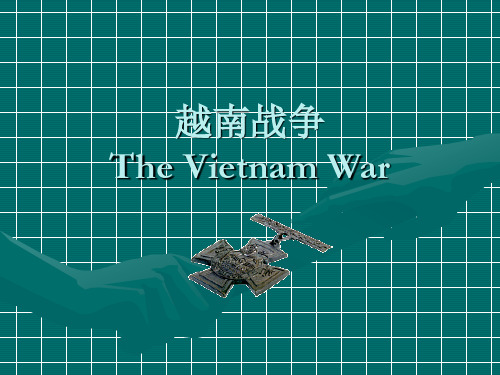
Why is the study of the Vietnam War significant for Australians ?
• • The study reveals the operation of LiberalLabor politics in the 1960‟s and 70‟s, with such significant politicians as Robert Menzies, Arthur Calwell and the rise of Gough Whitlam. Australia‟s commitment to Vietnam War reveals the growth in its foreign policy of Australia‟s alliance with America. A study of the causes of the Vietnam War reveals the legacy of post World War 11 power blocs and the subsequent Cold War. The impact of the war on Australian citizens is revealed in the growth of political activism and the Moratorium Movement. The Vietnam War was the first war fully exposed by the media. It became known as “ the lounge room war” The power of the media was shown in its impact on public opinion.
越南战争

越南战争中越南人民胜利的原因 越南人民反侵略战争的正义性 越南军民采取了正确的战略战术 越南得到世界各国人民的支持和声援,得 到社会主义国家特别是中国的大力支援 美军士气低落,国内反战运动高涨,美国 政府陷入内外交困的境地
思考:越南战争与朝鲜战争的异同
思路:从朝鲜战争与越南战争的起因、战争 进程及战争的结果和影响进行比较分析。
一.“印度支那问题”
1.范围
亚洲中南半岛 上的三个国家: 越南、老挝、 柬埔寨。
一.“印度支那问题”
2. 产生和发展
①二战前,为法国的殖民地 ②二战中,被日本占领 ③1945年,印度支那获得解放;但是法国在美国 支持下卷土重来,发动殖民侵略战争。 ④印度支那人民进行了长达九年的反法斗争 (1946--1954) ⑤1954年《日内瓦协议》承认三国的独立和主权; 规定越南分为南北两部分
在印度支那全部地区停火; 与会国尊重越南、老挝、柬埔寨的领土主权; 越南暂时以17度北纬为军事分界线,法军向分界线以 南集结。越南共产党在分界线以北集结。
印度支那问题
胡 志 明 吴 庭 艳
印度支那问题
北 越
胡志明 1930年2月,领导成立印度支那共 产党。1941年发起建立越南独立同盟,领 导反对法国殖民者和日本帝国主义的斗争。 1945年9月2日在河内宣布越南民主共和国 (简称:北越)成立,他出任临时政府主 席。1946年3月当选为越南民主共和国主席、 总理。1945年~1954年间,领导了抗法战争; 60年代又进行了抗美救国战争。
越南战争的影响
在战争中失去双腿的伦道夫〃巴克在接受《纽约 时报》采访时,愤怒地控诉道:“(政府)要我 们为了自由和理想去(越南)战斗,而战争却使 我永远失去了自由。而且至今我也不知道自己为 了一种什么样的理想和自由去战斗。每年我除了 与那些悲惨的战友们泪流满面地团聚外,似乎痛 苦与孤独就是我生活的全部。”
越南战争

Background:
3.America’s ambition
If Vietnam was conquered by America, it would be a threat to Soviet Union and China. It was America’s step to achieve global domination.
Basic information
1.Concept:The Vietnam War (the Second Indochina War)
2.Time: 1961—1973
3.Warring sides:
17’N
North Vietnam( Republic of Vietnam) ,supported by its communist allies,
Knowing little about the situation of Southeast Asia and lacking the experience and solution to the problem, the special warfare was raised in the south Vietnam This movement was to suppress the revolution of Vietnam people, protect the puppet government and restrain the expansion of communism in the world
From 1850s to World War II , Vietnam was colonized by France; During the WWII, it was under the control of Japan; From WWⅡ to 1955, France fought hard to regain their former territories in the region but was finally defeated in May 1954 by the communist Hu Chiming. The French troops withdrew, leaving a buffer zone separating the North and South
越南战争

美国在无法取胜的情况下,耗费了1389亿美元巨资,死伤35万人,经济受到严重影响,人民极为不满,青年纷纷拒服兵役,美国国内出现大规模反战运动,约翰逊政府下台。1973年,美国被迫签订“巴黎协定”,同意在60天内从越南撤退全部美军。美军撤退后,西贡政权于1975年宣布投降,越南战争结束。
日内瓦协议规定停战,法国政府尊重越南、柬埔寨和老挝三国的独立主权和统一,以北纬17度线为南北临时军事分界线,法国军队退出北越,越共军队退出南越。从此以后,南北越南分裂局面得以确立。
9年抗法战争中,法国损失惨重,耗资百亿美元,于1956年完全撤出越南。
美国政府拒绝在“日内瓦协议”上签字,并且立即接替法国,在南越建立吴庭艳傀儡政权,提供大量经济和军事援助,并积极修建美军基地。
同年9月21日,法国军队卷土重来,开进越南南部,拒绝承认越南独立,越南抗法战争开始。
1946年3月,法军进入越南北部,中国军队则撤回国内。法国当时与越南订立协定,承认越南是自由的国家,越南政府也承认越南是法兰西联邦一部分。
但是,法国在调集大量兵力到越南后,于同年12月撕毁协定,发起全面进攻,并且建立伪政权。
中华人民共和国成立后不久,胡志明秘密访华请求中国政府援助,中国政府当即给予大力援助,派出陈赓和韦国清等率领的军事顾问团帮助越军。
经多年战争,越南在中国援助下越战越强,并于1954年3月发动奠边府战役,此战越南军队战果辉煌,大败法军并且还迫使法军主力近万人投降,共歼敌1.6万人。法国政府无力再战,于1954年7月在中、苏、英、美、越等23国参加的日内瓦会议上,签定“日内瓦协议”。
第2课越南战争
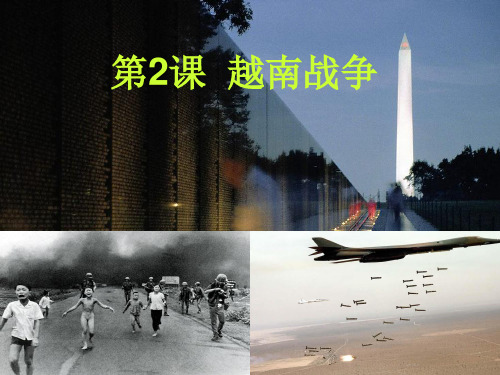
解放军于1965年5月~1973年8月,先后派出防空、 工程、铁道、后勤等部队23个支队和海军扫雷 工作队(12艘扫雷艇、4艘保障艇)共32万余人, 到越南北方担负防空作战、国防工程建设和扫 雷等任务。共对空作战2153次,击落美机1707 架,击伤1608架;中国援越部队有4200余名指 战员负伤,1070余名指战员牺牲并安葬在越南 的土地上,为越南人民抗美救国战争的胜利献 出了鲜血和生命。
韩国军队:死亡4500人。 澳大利亚军队:死亡500人,2400人受伤。
泰国军队:死亡350人。
新西兰军队:死亡83人。 总计:死:1299079人。伤:1410600人。失踪: 332000
越南战争中越南人民胜利的原因
越南人民反侵略战争的正义性 越南军民采取了正确的战略战术 越南得到世界各国人民的支持和声援,得 到社会主义国家特别是中国的大力支援 美军士气低落,国内反战运动高涨,美国 政府陷入内外交困的境地
北越:110万人死亡,60万人受伤,33万人失踪。 南越:死亡13万人,受伤50万人。
战争给越南留下了一片满目苍夷的土地和88万孤儿, 100万寡妇,20万残疾人 。
美军在越南大量使用化学武器落叶 剂(橙剂)
橙色剂是一种有毒化学落叶剂,含有剧毒有机化 合物二恶英。美军越南战争期间在越南丛林喷洒橙色 剂以破坏植被,旨在摧毁越南军队地面掩护。 越南方面说,100万至400万越南人可能遭受由橙 色剂中毒引发的严重疾病。 美联社报道,美越2006年着手举行年度会议,商 讨清理受美军喷洒橙色剂污染的地区。 双方眼下主要致力于清理位于岘港的一座机场。 美军越战期间使用这座机场作为空军基地。美军曾在 这里配制橙色剂并把它们用飞机运往目标地区喷洒。 美越研究人员发现,岘港地区土壤二恶英含量高出国 际标准300倍至400倍。 越南政府估计,清理岘港和其他两个橙色剂污染 严重地区将花费5800万美元。美国现阶段仅筹集800万 美元。
越南战争简介

越南在第二次世界大战爆发前是法国的殖民地,第二次世界大战进行中则被 日本占领。1945年第二次世界大战结束前后,胡志明领导的越南独立联盟(越南 共产党)在越南北方城市河内市建立越南民主共和国。法国则支持越南末代皇帝 保大皇帝在越南南方城市西贡市建国。
最先开始援助越南的美国总统是艾森豪 威尔;肯尼迪开始支持在越南作战;林登·约 翰逊将扩大。在尼克松执政时期,美国因国 内的反战浪潮,逐步将军队撤出越南。越南 人民军(北越军)和越共游击队最终打败了 越南共和国军(南越军),统一了全越南。
北越 南越
大事记
1961年5月美国在越南共和国发动特种战争。 1963年11月在美国策划的军事政变中,越南共和国总统吴廷琰被击毙;杨文明和阮庆先后当 选总统。 1964年8月美国制造北部湾事件,开始轰炸越南民主共和国。 1965年3月美国国防军在越南共和国岘港市登陆,把越南战争升级为以美国为主的局部战争; 6月越南共和国军人阮文绍发动政变上台,成立战时内阁,任越南共和国国家领导委员会主 席。 1967年4月越南共和国制宪议会通过新宪法;9月阮文绍当选越南共和国总统。 1968年3月美国被迫宣布部分停止轰炸越南民主共和国。5月越南民主共和国和美国在法国 首都巴黎开始举行会谈。10月美国全面停止轰炸越南民主共和国。 1969年1月越南民主共和国和美国的会谈扩大为越南南方民族解放阵线和越南共和国的四方 会谈。美国在越南共和国开始推行战争越南化政策。6月越南南方民族解放阵线宣布成立以 黄晋发为首的越南南方共和革命临时政府;9月越南民主共和国主席胡志明去世,孙德胜当 选主席。 1973年1月27日越南民主共和国、越南反政府武装·越南南方民族解放阵线、美国、越南共和 国签署《关于在越南战争结束、恢复和平的协定》;3月29日美国国防军完全从越南共和国 撤出。 越南战争历时30年,美国3.8万人死亡、30万人受伤,耗费4450亿美元;越南战争给美国人 民造成了无法估量的心灵创伤,美苏争霸的格局因此而向有利于苏联的转化。 1975年4月30日越南人民军解放越南共和国首都西贡市,越南共和国覆灭,越南战争结束。 1976年1月2日越南社会主义共和国成立,越南统一。
越南战争是哪一年

越南战争是哪一年
推荐文章
秋季防御作战相关资料热度:辛亥革命失败的原因有哪些热度:古印度的历史发展热度:近现代历史知识点热度:法国贝洛森林战役热度:
越南战争是哪一年开始的?在1955年,独裁专制的南越政府发起了屠杀北越共产党的战役,北越政府勃然大怒,便予以还击,因此走上了推翻南越政府完成国家统一的道路,爆发了越南战争。
只是后来随着美国的军事介入,战争的局势开始变得紧张起来,那越南战争是哪一年开始出现第一批美国国防军战斗人员的呢?1964年,南越联合美国摧毁北越的军事基地,愤怒的北越政府决定予以强烈反击,不仅攻击美国驱逐舰,还袭击了美国多处军事基地,美国政府因此通过出兵越南的议案,在1965年派出了第一批国防军战斗人员。
这是美国在冷战背景下的做出的失误策略,因此展开了其历史上持续时间最长的战争。
虽然对手实力强大,但北越阵营并不气馁,他们聪明地采取了恐怖袭击以及游击战的方式来应战,并最终赢取胜利。
北越的民族解放阵线在牺牲了117万条生命,支援北越的中国也因此牺牲了一千多人。
而南越军队死亡人数达22万,美国军队伤亡情况也不轻,伤亡人数达36万,除此以外,美国还为战争耗费了大量财力,甚至还严重影响了其国内的经济状况。
据估计,战争死亡人数总计200万左右,光是平民就起码死了50万左右。
对于付出代价最为惨重的越南,其后人应当记得越南战争是哪一年发生的,记得先人为国家统一付出的沉重代价,珍惜来之不易的和平。
越南战争课件

不同:
(1)过程: 朝鲜战争持续3年,美国打着联合国的旗号进行侵略,使从内 战扩大为一场国际性的局部战争。 越南战争持续10多年,是美国在南越进行的特种战争扩大为 侵略整个越南的局部战争。 (2)对中美关系影响: 朝鲜战争后,美国对中国实行长期封锁,致使两国关系长期 处于敌对状态; 越南战争后期,美国内外交困,不得不实行战略收缩,改善 与中国的关系。
其亚洲扩张的主要障碍。
(3)在东西两大阵营对抗的大背景下,美国 为“遏制共产主义”在亚洲建立起“东南亚条 约组织”和“巴格达条约组织” ,并提出所 谓“多米诺骨牌论” (4)50年代中期,越南分裂。美国加紧干涉
越南内政,支持南越政权,为以后的大规模侵
越战争创造条件。
越南方面两个人物
• 1/胡志明 1930年2月,领导成立印度支那 共产党。1941年发起建立越南独立同盟, 领导反对法国殖民者和日本帝国主义的斗 争。1945年9月2日在河内宣布越南民主共 和国(简称:北越)成立,他出任临时政 府主席。1946年3月当选为越南民主共和国 主席、总理。1945年~1954年间,领导了 抗法战争;60年代又进行了抗美救国战争。
么关系?其结果又对冷战格局产生了什么影响?
1、二战后,美国在全球实行争夺世界霸权 、遏制共产主义的政策。 2、为配合对苏联等社会主义国家实施的冷 战政策,在亚洲发动了侵略越南的战争。
二战后美国的总体战略是对苏冷战,东亚“热战”是冷战的补偿, 是冷战的产物,是冷战中的热战。
背景
影响
1、使美国政府陷入内外交困的境地,使其 不得不实行战略收缩。 2、从20世纪70年代起,在美苏两国之间的 争夺中,呈现出苏攻美守的态势。
1.结果: 1973年,美军撤出越南
1975年,越南实现统一
越南战争
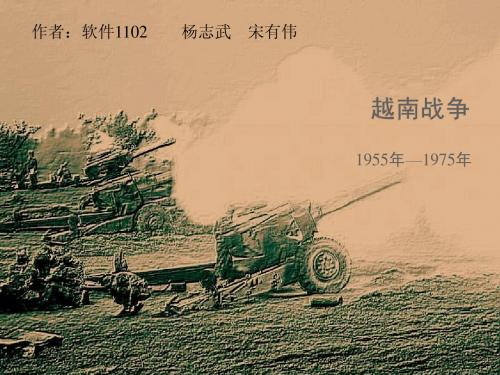
第四阶段
尼克松政府提出“越南化”政策,重新采 用“用越南人打越南人”的手段,同时宣布从 南越逐步撤出美国部队。美越继续会谈,并将 双方会谈扩大为包括南方民族解放阵线及西贡 阮文绍政权在内的四方会谈。 1973年1月27日,美国被迫在结束越南战争 的协定上签字。为时12年的侵越战争到此结束。
第五阶段
本次讲演此结束,谢谢欣赏
Thanks~
战争的开始
1961年5月为了进一步帮助越南共和国总统吴 廷琰的政府,美国总统肯尼迪派遣一支美国国防军 特种部队进驻越南共和国,开启了美国国防军战斗 部队进入越南的先河。这一事件也常被认为是越南 战争开始的标志。
越南战争老照片
1
2
3
五个阶段
越南战争从1955年起 到1975年,前后历时 20年,分为五个阶段。 其中,第二、三、四 阶段(1961~1973 年) 为美国侵越战争时期。
最后我想说的是:战争是产生在人类身上的毒瘤。 正如现在的人们还没法疗治癌症一样,人类当前也还消 除不了战争。 恩格斯那句“人来自动物界的事实决定人永远也不 能摆脱兽性”的定性语言使我们悲哀。既然这样,我们 的责任就是尽量团结起来反对战争,尽量限制一些人的 战争行为,让他们的兽性发挥得少些,再少些……
作者:软件1102
杨志武 宋有伟
越南战争
1955年—1975年
简介
越南战争(1955年—1975年),简称越 战,又称第二次印度支那战争,越南共产党 称抗美救国战争,为越南共和国(南越)及 美国对抗越南民主共和国(北越)及“越南 南方民族解放阵线”(又称越共)的一场战 争。 越战是二战以后美国参战人数最多、影 响最重大的战争,也是该国至今唯一战败的 战争。北越政府军和南越解放军最终打败了 南越政府军队,统一越南。
越南战争的结果和启示

越南战争的结果和启示越南战争是一场影响深远的冲突,于20世纪60年代至70年代在越南半岛展开。
这场战争的结果带来了诸多影响,并为世界带来了许多重要的启示。
本文将探讨越南战争的结果以及从中得到的启示。
一、结果1. 战争的结束越南战争于1975年结束,胜利方为越南人民军和南方解放阵线。
南越政府的覆灭,统一了越南,并将南越纳入北越的统治之下。
2. 北南分裂的消除越南战争结束后,北南分裂的局面被消除。
越南统一为社会主义国家,北越的社会主义体制在南方推行。
这也为越南人民提供了更好的统一和发展的机会。
3. 战争的影响和损失越南战争造成了庞大的人员伤亡和财产损失。
根据统计,战争导致逾200万人丧生,超过100万人负伤。
同时,大量的基础设施被摧毁,农田和森林遭受破坏,对越南的经济和环境造成了持续的影响。
4. 对美国的影响和教训越南战争对美国来说,是一次惨重的失败。
这场战争不仅耗费了大量的金钱和资源,还导致了美国公众的抗议和社会动荡。
这一失败事实深刻地影响了美国的外交政策,并对其在全球范围内的影响产生了深远的影响。
二、启示1. 和平解决问题的重要性越南战争教导我们,和平解决问题的重要性是不可忽视的。
战争带来的破坏和伤亡是巨大的,通过对话和谈判解决争端将更有利于各方的长期利益。
2. 尊重国家主权和民族意志越南战争也告诉我们,尊重国家主权和民族意志至关重要。
外国干涉越南内政最终未能实现其意图,只会激起越南人民更强大的抵抗。
这为我们提供了重要的教训,我们应该尊重他国的独立和民族意志。
3. 冷战思维的警示越南战争还对冷战思维提出了警示。
这场战争是冷战中的一部分,受到了两个阵营的干预和支持。
然而,冷战思维的斗争和对抗只会造成更多的伤亡和破坏。
我们应该超越意识形态的差异,追求和平与合作。
4. 重视经济发展和人民福祉越南战争给我们带来的启示之一是,经济发展和人民福祉应该是国家发展的核心。
战争给人民带来了巨大的痛苦,而国家的稳定和繁荣来自于人民群众的稳定和繁荣。
越南战争英文介绍【精品】

-Gulf of Tonkin (1964) US destroyer Maddox was fired on by North Vietnamese torpedo boats Gave broad congressional approval for the expansion of the Vietnam War -Tet Offensive (1968) Consisted of a series of sharp attacks on urban and rural areas in South Vietnam by the Vietcong -Paris Peace Agreement (January 1973) United States and North Vietnam signed which provided the withdrawal of all remaining U.S. forces from Vietnam -The Fall of Saigon (April 30, 1975) Capture of Saigon, the capital of South Vietnam by North Vietnamese Army; event marked the end of the Vietnam War
Timeline of Key Events
-Battle of Dien Bien Phu (1954) Starts US Evolvement in Vietnam War
/topics/vietnam-war/audio#dien-bien-phu-falls
Wounded soldier being taken off the battlefield
第2课越南战争ppt课件
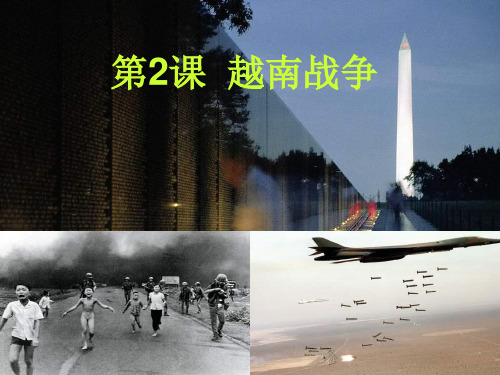
一.“印度支那问题”
1.范围
亚洲中南半岛 上的三个国家: 越南、老挝、 柬埔寨。
一.“印度支那问题”
2. 产生和发展
①二战前,为法国的殖民地 ②二战中,被日本占领 ③1945年,印度支那获得解放;但是法国在美国 支持下卷土重来,发动殖民侵略战争。 ④印度支那人民进行了长达九年的反法斗争 (1946--1954) ⑤1954年《日内瓦协议》承认三国的独立和主权; 规定越南分为南北两部分
巴格达条约组织:
为了与苏在中近东展开争夺,在美国积极推动下, 英国、土耳其、伊拉克、伊朗建立的军事集团。 巴格达条约组织建立后,中东分成了两大阵营,一 是北方得到美国财政和军事支持的巴格达条约组织 国家,另一方是以埃及为首的阿拉伯国家,这使中 东形势更为复杂,留下了冲突的种子。
思考:美国干涉越南问题的真正目的是
1969年5月22日 美国反战学生占领大学校园
美军:死亡5.8万人, 受伤30.4万人, 2000民共和国: 死亡1,446人,受伤4,200人
中国是北越最主要的支持者和援助者。出于地 缘政治的考虑,也加上意识形态的因素,中国 给予了越南超过二百亿人民币的援助,客观上 加剧了中国经济的负担。 统一后的越南并未成为中国可靠的盟友,出于 担心国家利益受到柬埔寨极端政治势力和中国 的损害他倒向了苏联。在1979年,因为越南入 侵柬埔寨,破坏了地区均势,中国出兵越南, 导致中越战争。
332000越南战争中越南人民胜利的原因越南人民反侵略战争的正义性越南军民采取了正确的战略战术越南得到世界各国人民的支持和声援得到社会主义国家特别是中国的大力支援越南得到世界各国人民的支持和声援得到社会主义国家特别是中国的大力支援美军士气低落国内反战运动高涨美国政府陷入内外交困的境地美军士气低落国内反战运动高涨美国政府陷入内外交困的境地思考
越南战争的简介
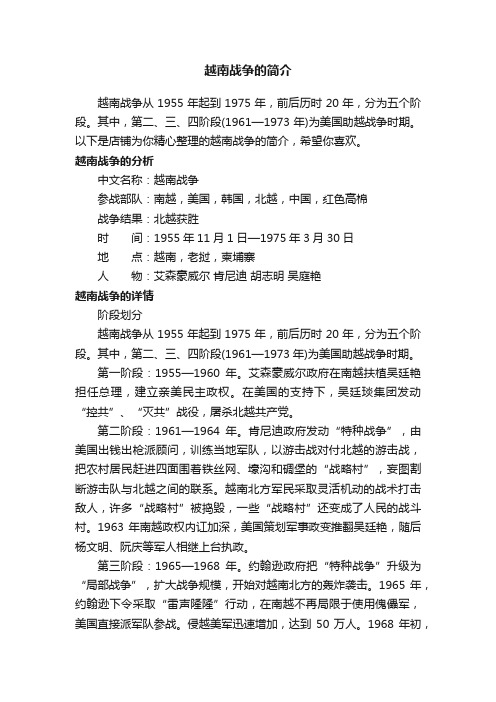
越南战争的简介越南战争从1955年起到1975年,前后历时20年,分为五个阶段。
其中,第二、三、四阶段(1961—1973年)为美国助越战争时期。
以下是店铺为你精心整理的越南战争的简介,希望你喜欢。
越南战争的分析中文名称:越南战争参战部队:南越,美国,韩国,北越,中国,红色高棉战争结果:北越获胜时间:1955年11月1日—1975年3月30日地点:越南,老挝,柬埔寨人物:艾森豪威尔肯尼迪胡志明吴庭艳越南战争的详情阶段划分越南战争从1955年起到1975年,前后历时20年,分为五个阶段。
其中,第二、三、四阶段(1961—1973年)为美国助越战争时期。
第一阶段:1955—1960年。
艾森豪威尔政府在南越扶植吴廷艳担任总理,建立亲美民主政权。
在美国的支持下,吴廷琰集团发动“控共”、“灭共”战役,屠杀北越共产党。
第二阶段:1961—1964年。
肯尼迪政府发动“特种战争”,由美国出钱出枪派顾问,训练当地军队,以游击战对付北越的游击战,把农村居民赶进四面围着铁丝网、壕沟和碉堡的“战略村”,妄图割断游击队与北越之间的联系。
越南北方军民采取灵活机动的战术打击敌人,许多“战略村”被捣毁,一些“战略村”还变成了人民的战斗村。
1963年南越政权内讧加深,美国策划军事政变推翻吴廷艳,随后杨文明、阮庆等军人相继上台执政。
第三阶段:1965—1968年。
约翰逊政府把“特种战争”升级为“局部战争”,扩大战争规模,开始对越南北方的轰炸袭击。
1965年,约翰逊下令采取“雷声隆隆”行动,在南越不再局限于使用傀儡军,美国直接派军队参战。
侵越美军迅速增加,达到50万人。
1968年初,越南南方军民发动“春季攻势”,向西贡、顺化、岘港等64个大中城市、省会及军事基地展开猛烈进攻。
同年3月,约翰逊政府被迫宣布部分停止对北越的轰炸。
5月越美巴黎谈判开始。
11月美国宣布完全停止对越南北方的轰炸。
至此,“局部战争”结束。
第四阶段:1969—1973年。
[哲学历史]越南战争
![[哲学历史]越南战争](https://img.taocdn.com/s3/m/d8626c13f68a6529647d27284b73f242336c31e0.png)
越南战争越南战争或越战(1961年—1975年)是美国和越南共产党游击队之间的战争,是二战以来美国参与的伤亡人数最多的战争,也是冷战的一部份。
美国为防止共产主义在东南亚获得政权,出兵越南帮助南方吴庭艳政府。
越南北方领导人胡志明由于具有共产党身份,因此帮助越共游击队。
最开始援助南越的是艾森豪威尔,约翰·菲茨杰拉德·肯尼迪开始支持在越南作战,后有撤兵意图,但还没来得及行动即被暗杀,接替的总统林登·约翰逊将战争扩大到不可收拾的地步。
在尼克松执政时期,美国因国内的反战浪潮,逐步将军队撤出越南。
越南南方军队被共军消灭,越南在共产党执政之下获得统一。
越南战争Vietmam War越南战争(1955年——1975年) ,南越和美国为阻止北越共产党人在其领导下将南越与北越统一所作的长期而不成功的努力。
越南独立同盟会(通称越盟)于1941年成立,它是争取越南脱离法国而独立的民族主义政党。
直到50年代中期,它才公开成为共产主义者。
1945年9月2日,即第二次世界大战日本投降后不到一个月,越盟领袖胡志明正式宣布越南脱离法国独立。
越盟在越南北部拥有坚强的民众基础。
但法国想要坚持其对印度支那的控制,仅愿承认越南为法兰西联邦内的一个自由邦。
法国与越盟之间的战争于1946年爆发,并持续到1954年法军在奠边府战役中遭到惨败。
1954年日内瓦国际会议就法国和越盟之间的停火问题进行谈判。
为了隔离敌对兵力,参加会议的各方决定,法军及在法军指挥下作战的越军撤至北纬17°线以南,越盟撤至北纬17°线以北,17°线成为军事分界线,周围建立非军事区(DMZ)。
数千人民遂据此向北或向南离开他们的家园,法军则开始最后撤离越南。
这一协议使共产党人领导的越盟控制了越南北半部,成为北越,而非共产党的越南南半部则成为南越。
吴庭艳在停战谈判期间成为南越的总理。
《日内瓦协议》(Geneva Accords)规定,越南全境在国际管制委员会监督下于1956年举行自由选举,目的是在单一的民选政府的领导下重新统一南北越。
越南战争_410308748

(二)中国人说话是算数的。那就是,如果亚洲、非洲或世界上任何国
家遭到以美国为首的帝国主义的侵略,中国政府和中国人民是一定要给以支持和援 助的。如果由于这种正义行动引起美国侵犯中国,我们将毫不犹豫地奋起抵抗,战 斗到底。
(三)中国是做了准备的。如果美国把战争强加于中国,不论它来多少
人,用什么武器,包括核子武器在内,可以肯定地说,它将进得来,出不去。既然 一千四百万越南南方人民对付得了二十几万美军,那么六亿五千万中国人民也肯定 对付得了一千万美军。美国侵略者不管来多少,必将被消灭在中国。
1975年4月30日,越南攻克西贡, 取得了抗美救国战争的彻底胜利,
周恩来总理谈中美战争(1966.4)
(一)中国不会主动挑起对美国的战争。中国没有派兵去夏威夷,
是美国侵占了中国领土台湾省。尽管这样,中国仍然努力通过谈判要求美国从台湾 省和台湾海峡地区撤走它的一切武装力量,并且已经先后在日内瓦和华沙同美国就 这个绝不能让步的原则问题谈了十多年。这就是一个很好的证明。
1954年5月7日,越南人 民取得奠边府战役的胜利, 从根本上改变了印度支那 战场形势,对迫使法国签 订停战协定起了决定性作 用。5月8日,日内瓦会议 进入关于恢复印度支那和 平问题的讨论。与会国有 中国、苏联、美国、英国、 法国、越南民主共和国、 越南共和国(即南越)、老 挝和柬埔寨王国。7月20、 21日,会议通过了《印度支 那停战协定》和《日内瓦 会议最后宣言》(统称 《日内瓦协议》)。
美军《越南作战手册》中有这 样的文字:“一个活着的越南 人,就可能是越共;一个死了 的越南人,就一定是越共。”
2000.4.1参考消息
美军在越南大量使用化学武器落 叶剂(橙剂)
美军在越南的战争激发了美国内 各种矛盾
- 1、下载文档前请自行甄别文档内容的完整性,平台不提供额外的编辑、内容补充、找答案等附加服务。
- 2、"仅部分预览"的文档,不可在线预览部分如存在完整性等问题,可反馈申请退款(可完整预览的文档不适用该条件!)。
- 3、如文档侵犯您的权益,请联系客服反馈,我们会尽快为您处理(人工客服工作时间:9:00-18:30)。
Opposition to Geneva Accords
• The United States prevented the elections that were promised under the Geneva conference because it knew that the Communists would win.
– Secretary of State John Foster Dulles thought the Geneva Accords granted too much power to the Communist Party of Vietnam. – He and President Dwight D. Eisenhower supported the creation of a counter-revolutionary alternative south of the 17th parallel.
Where is Vietnam?
Why Did the United States Fight a War in Vietnam?
• Basically to hold the line against the spread of world Communism. America paid for the war the French fought against Communist Vietnam as a part of the Truman Doctrine (1947) “to help free peoples to maintain their free institutions and their national integrity against … totalitarian regimes.” In the 1950’s, America became involved again.
South Vietnam Under Diem
• Diem claimed that his newly created government was under attack from Communists in the north. • In late 1957, with American military aid, Diem began to counterattack.
Opposition to Diem
• The outcry against Diem's harsh and oppressive actions was immediate.
– Buddhist monks and nuns were joined by students, business people, intellectuals, and peasants in opposition to Diem’s corrupt rule. – The more these forces attacked Diem's troops and secret police, the more Diem complained that the Communists were trying to take South Vietnam by force. This was "a hostile act of aggression by North Vietnam against peace-loving and democratic South Vietnam."
• This was accomplished through formation of the Southeast Asia Treaty Organization (SEATO).
A New Nation in the South
• Using SEATO for political cover, the Eisenhower administration helped create a new nation in southern Vietnam. • In 1955, with the help of massive amounts of American military, political, and economic aid, the government of the Republic of Vietnam (South Vietnam) was born. • The following year, Ngo Dinh Diem, a staunchly anti-Communist figure from the South, won a dubious election that made him president of South Vietnam
December 1961 White Paper
• In 1961, President Kennedy sent a team to Vietnam to report on conditions in the South and to assess future American aid requirements. • The report, known as the "December 1961 White Paper," argued for:
Hale Waihona Puke The National Liberation Front
• The Communists supported the creation of a broad-based united front to help mobilize southerners in opposition to the government in South Vietnam. • On December 20, 1960, the National Liberation Front (NLF) was born.
• The oldest man killed was 62 years old; the youngest, 16. • 61% of the men killed were 21 or younger.
– 304,000 were wounded. – 75,000 were severely disabled. – The United States spent over $200 billion dollars on the war.
Conflict Between France & Vietnam
• The Vietnam War grew out of the long conflict between France and Vietnam.
– In July 1954, after one hundred years of colonial rule, a defeated France was forced to leave Vietnam. – Nationalist forces under the direction of General Vo Nguyen Giap defeated the allied French troops at the remote mountain outpost of Dien Bien Phu in the northwest corner of Vietnam.
– He used the help of the CIA (through Operation Phoenix) to identify those who sought to bring his government down and arrested thousands. – He passed a repressive series of acts known as Law 10/59 that made it legal to hold suspected Communists in jail without bringing formal charges.
The Domino Theory
• American policymakers developed the “Domino Theory” as a justification for the involvement. This theory stated, “If South Vietnam falls to the Communist, Laos, Cambodia, Thailand, Burma, India and Pakistan would also fall like dominos. The Pacific Islands and even Australia could be at risk”.
– An increase in military, technical, and economic aid – The introduction of large-scale American "advisers" to help stabilize the Diem regime and crush the NLF.
Longest and Most Unpopular War
• The Vietnam War was the longest and most unpopular war in American history. During the war:
– 58,000 Americans lost their lives.
The Geneva Peace Accords
• The Geneva Peace Accords, signed by France and Vietnam in the summer of 1954, provided for the temporary partition of Vietnam at the 17th parallel, with national elections in 1956 to reunify the country. • In the North, a communist regime, supported by the Soviet Union and the People's Republic of China, set up its headquarters in Hanoi under the leadership of Ho Chi Minh.
